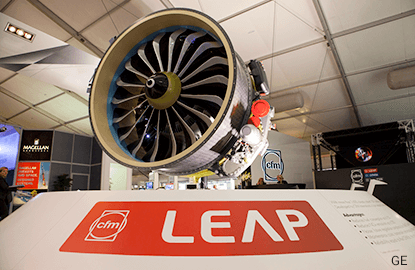

When an Airbus A380 flew non-stop from Dubai to Auckland this year, it covered 14,200km, thus making it the longest non-stop commercial flight by distance. But the record looks set to be broken in the not too distant future, as a new and unusual material is now changing the aviation industry: ceramics.
These ceramics are not your typical cup of tea. Jet engines with parts made from ceramic matrix composites (CMCs) could make flying New York to Sydney, a journey covering 16,000km, a reality soon. The light, tough and heat-resistant material will allow engineers to build lighter and more efficient engines that can take planes farther and burn less fuel.
Static components made from CMCs are already serving in the newest and most advanced civilian and military engines like the LEAP engine made by CFM International, a joint venture between GE Aviation and France’s Safran Aircraft Engines.
“Going from nickel alloys to rotating ceramics inside the engine is the really big jump. CMCs allow for a revolutionary change in jet engine design,” said Jonathan Blank, who leads CMC and advanced polymer matrix composite research at GE Aviation.
The material has two hugely winning attributes for aviation: it is one-third the weight of metal, it is heat-resistant and does not need to be air-cooled.
The turbines of most modern jet engines work with high surface temperatures, which can make even advanced alloys grow soft. Engineers use lasers to drill tiny holes in the metal alloy turbine blades to bleed in cooling air and protect their surface from the heat. But the cooling air also reduces engine performance.
“More heat means more cooling air, which lowers overall efficiency. When you drop the need for cooling components, your engine will become aerodynamically more efficient and also more fuel efficient,” Blank said.
Since the rotating turbine blades made from CMCs are so light, they also allow engineers to reduce the size of the metal disks to which they are attached.
“This is pure mechanics. The lighter blades generate smaller centrifugal force, which means that you can also slim down the disk, bearings and other parts,” Blank said.
GE just recently finished the world’s first successful test of rotating CMC blades inside an F414 military jet engine, which normally powers F/A-18 Hornet and Super Hornet jets. They were able to run the engine for 500 cycles. (One cycle takes the engine to take-off thrust and back.)
The blades powered through punishing dynamic forces and high temperatures inside the engine’s low-pressure turbine, giving engineers another proof that the heat-resistant technology that can withstand unprecedented conditions.
Blank said that thanks to CMCs, GE’s ADVENT adaptive cycle engine had already set the world record for the highest combined compressor and turbine temperatures. This was validated by the Air Force Research Lab.
The first application of the blades could be inside new jet engines for “sixth-generation” fighter jets, like the ADVENT.
“But we already envision future commercial applications,” Blank said.
GE Reports Malaysia provides the latest news on science, technology and innovation. Stay ahead with the latest industry insights. Subscribe today at www.gereports.com.my.